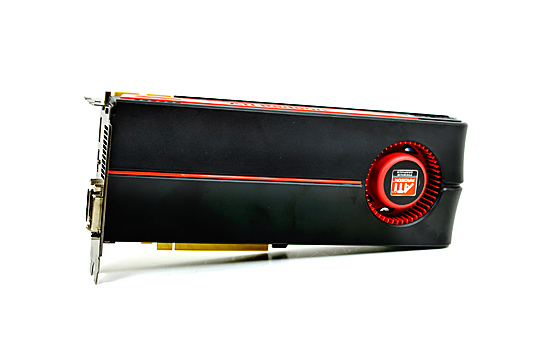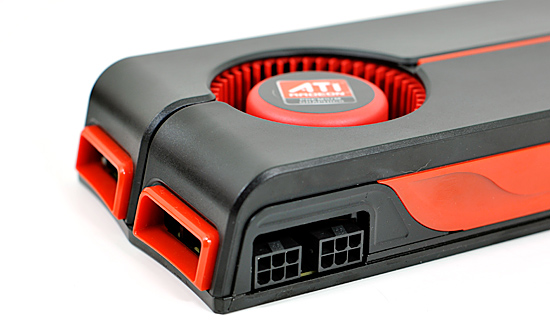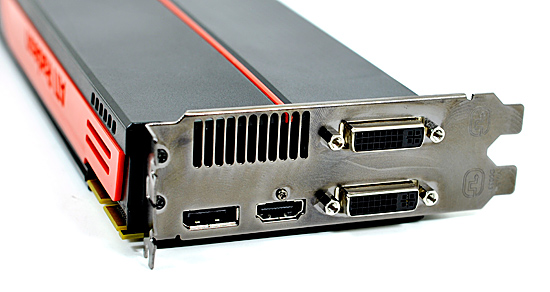AMD's Radeon HD 5870: Bringing About the Next Generation Of GPUs
by Ryan Smith on September 23, 2009 9:00 AM EST- Posted in
- GPUs
Meet the 5870
The card we’re looking at today is the Radeon HD 5870, based on the Cypress core.

Compared to the Radeon HD 4870, the 5870 has seen some changes to the board design. AMD has now moved to using a full sheath on their cards (including a backplate), very much like the ones that NVIDIA has been using since the 9800GTX. The card measures 10.5” long, an inch longer than the 4890 or the same as the 4870x2 and the NVIDIA GTX lineup.
The change in length means that AMD has moved the PCIe power connectors to the top of the card facing upwards, as there’s no longer enough room in the rear. Facing upwards is also a change from the 4870x2, which had them facing the front of the card. This, in our opinion, makes it easier to plug and unplug the PCIe power connectors, since it’s now possible to see what you’re doing.
Since the card has a TDP of 188W, AMD can still get away with using two 6-pin connectors. This is going to be good news for those of you with older power supplies that don’t feature 8-pin connectors, as previously the fastest cards without 8-pin connectors were the 4890 and GTX 285.

Briefly, the 5850 that we are not testing today will be slightly smaller than the 5870, coming in at 9.5”. It keeps the same cooler design, however the PCIe power connectors are back on the rear of the card.
With the 5800 series, DisplayPort is getting a much-needed kick in the pants. DisplayPort (full size) is standard on all 5800 series cards – prior to this it has been rather absent on reference cards. Along with a DisplayPort, the 5870 reference card contains a dedicated HDMI port, and a pair of DVI ports.
Making 4 ports fit on a card isn’t a trivial task, and AMD has taken an interesting direction in making it happen. Rather than putting every port on the same slot of the bracket as the card itself, one of the DVI ports is raised on to the other bracket. ATI could have just as easily only equipped these cards with 1 DVI port, and used an HDMI-to-DVI adapter for the second port. The advantage of going this direction is that the 5800 series can still drive two VGA monitors when using DVI-to-VGA adapters, and at the same time having an HDMI port built in means that no special adapters are necessary to get an HDMI port with audio capabilities. The only catch to this specific port layout is that the card still only has enough TMDS transmitters for two ports. So you can use 2x DVI or 1x DVI + HDMI, but not 2x DVI + HDMI. For 3 DVI-derived ports, you will need an active DisplayPort-to-DVI adapter.
With the configuration AMD is using, fitting that second DVI port also means that the exhaust vent of the 5800 series cards is not the full length of the card as is usually common, rather it’s a hair over half the length. The smaller size had us concerned about the 5870’s cooling capabilities, but as you’ll see with our temperature data, even with the smaller exhaust vent the load temperatures are no different than the 4870 or 4850, at 89C. And this is in spite of the fact that the 5870 is rated 28W more than the 4870.

With all of these changes also comes some changes to the loudness of the 5870 as compared to the 4870. The 27W idle power load means that AMD can reduce the speed of the fan some, and they say that the fan they’re using now is less noticeable (but not necessarily quieter) than what was on the 4870. In our objective testing the 5870 was no quieter than any of the 4800 series cards when it comes to idling at 46.6dB, and indeed it’s louder than any of those cards at 64dB at load. But in our subjective testing it has less of a whine. If you go by the objective data, this is a push at idle and louder at load.
Speaking of whining, we’re glad to report that the samples we received do not have the characteristic VRM whine/singing that has plagued many last-generation video cards. Most of our GTX cards and roughly half of our 4800 series cards generated this noise under certain circumstances, but the 5870 does not.
Finally, let’s talk about memory. Despite of doubling just about everything compared to RV770, Cypress and the 5800 series cards did not double their memory bandwidth. Moving from the 4870 and it’s 900MHz base memory clock, the 5870 only jumps up by 33% to 1.2Ghz, in effect increasing the ratio of GPU compute elements to memory bandwidth.
When looking back at the RV770, AMD believes that they were not bandwidth starved on the cards that used GDDR5. And since they had more bandwidth than they needed, it was not necessary to go for significantly more bandwidth for Cypress. This isn’t something we can easily test, but in our benchmarks the 5870 never doubles the performance of the 4870, in spite of being nearly twice the card. Graphics processing is embarrassingly parallel, but that doesn’t mean it perfectly scales. The different may be a product of that or a product of the lack of scaling in memory bandwidth, we can’t tell. What’s for certain however is that we don’t have any hard-capped memory bandwidth limited situations, the 5870 always outscores the 4870 by a great deal more than 33%.










327 Comments
View All Comments
dieselcat18 - Saturday, October 3, 2009 - link
It truly amazes me that AnandTech allows a Troll like you to keep posting...but there is always one moron that comes to a forum like this and shows his a** to the world...So we all know it to be you...nice work not bringing anything resembling an intelligent discussion to the table..Oh and please don't tell me what it is that I bring to the conversation...my thoughts about this topic have nothing to do with my reply to you about your vulgar manner and lack of respect for anyone that has a difference of opinion.Oh and as for you paper launch...well sites like Newegg were sold out immediately because of the overwhelming demand for this card and I'll bet you anything there are cards available and in good supply at this very moment...Why don't you take a look and give us all another update.....I guess having that big "L" stamped on your forehead sums it up.....
SiliconDoc - Wednesday, September 23, 2009 - link
No, they didn't, because the 5870's just showed up last night, 4 of them, and just a bit ago the ONE of them actually became "available", the Powercolor brand.The other three 5870's are NOT AVAILABLE but are listed....
So "ATI paper launch" is the key idea here (for non red roosters).
1:43 PM CST, Wed. Sept. 23rd, 2009.
---
Yes, I watched them appear on the egg last night(I'm such a red fanboy I even love paper launches)... LOL
crimson117 - Wednesday, September 23, 2009 - link
Current cheapest GTX 295 at Newegg is $469.99.http://www.newegg.com/Product/Product.aspx?Item=N8...">http://www.newegg.com/Product/Product.a...p;cm_re=...
B3an - Wednesday, September 23, 2009 - link
Ryan, on your AA page, you have an example of the unofficial Nvidia SSAA where the tree branches have gone missing in HL2. And say because of this it's not suitable for general use.But for both the ATI pics, on either MSAA or SSAA, the tree branches are missing as well. Did you not notice this? because you do not comment on it.
Either way it looks like ATI AA is still worse, or there is a bug.
Ryan Smith - Wednesday, September 23, 2009 - link
We used the same save game, but not the same computer. These were separate issues we were chasing down at the same time, so they're not meant to be comparable. In this case I believe some of the shots were at 1600x1200, and others were at 1680x1050. The result of which is that the widescreen shots are effectively back a bit farther due to the use of the same FOV at all times in HL2.As you'll see in our Crysis shots, there's no difference. I can look in to this issue later however, if you'd like.
chizow - Wednesday, September 23, 2009 - link
Really enjoyed the discussion of the architecture, new features, DX11, Compute Shaders, the new AF algorithm and the reintroduction of SSAA an ATI parts.As for the card itself, its definitely impressive for a single-GPU but the muted enthusiasm in your conclusion seems justified. Its not the definite leader for single-card performance as the 295 is still consistently faster and the 5870 even fails to consistently outperform its own predecessor, the 4870X2.
Its scaling problems are really odd given its internals and overall specs seem to indicate its just RV790 CF on a single die, yet it scales worst than the previous generation in CF. I'd say you're probably onto something thinking AMD underestimated the 5870's bandwidth requirements.
Anyways, nice card and nice effort from AMD, even if its stay at the top is short-lived. AMD did a better job pricing this time around and will undoubtedly enjoy high sales volume with little competition in the coming months with Win 7's launch, up until Nvidia is able to counter with GT300.
chizow - Wednesday, September 23, 2009 - link
Holy....lolI didn't even realize til I read another comment that Ryan Smith wrote this and not Anand/Derek collaboration. That's a compliment btw, it read very Anand-esque the entire time! ;-) Really enjoyed it similar to some of your earlier efforts like the 3-part Vista memory investigation.
formulav8 - Wednesday, September 23, 2009 - link
I wouldn't be surprised if most of us already knew what was going to take place with performance and what-not. But its still a nice card whether I knew the specs before its official release or not. (And viewed many purposely leak benches). :)Jason
PJABBER - Wednesday, September 23, 2009 - link
Another fine review and nice to see it hit today. Your reviews are one reason I keep coming back to AT!Unfortunately, at MSRP the 5870 doesn't offer enough for me to move past the 4890 I am currently using, and bought for $130 during one of the sales streaks a month or so ago. Will re-evaluate when we actually start seeing price drops and/or DX11 games hit the shelves.
wicko - Wednesday, September 23, 2009 - link
It would have been nice to see 4890 in CF against 5870 in CF. 500$ spent vs 800$ spent :p